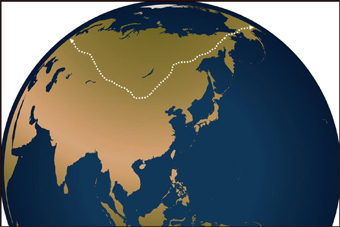
A Road Trip on Three Continents
| published April 11, 2015 |
By Thursday Review staff
Are you ready to be the first person in your neighborhood or town to take the longest road trip by car in history?
Though it may take a decade or two to complete, and though it will require years of permitting, engineering studies, and lots of international cooperation, the transportation conglomerate Russian Railways has officially proposed the construction of a superhighway and rail belt connecting western Europe to the easternmost tip of Siberia, followed by a massive super-bridge—jointly funded by Russia, Canada, China, and the U.S.—to span the Bering Sea and connect Siberia to Alaska.
The road would then traverse Alaska and western Canada, and link up with the U.S. interstate highway system near Grand Forks and Fargo, North Dakota. Once completed, the visionaries who support the project say that one could drive a car, truck or van from the Netherlands to Washington, D.C. without the use of a ferry or boat. One version of the plan would link up London to the European side of the English Channel as well.
Once completed, the highway would become the largest public works project ever attempted, and—possibly—the most expensive.
The plan includes multiple components: a limited-access highway (four to six lanes) with a barrier to divide opposing flows of traffic; a high-speed rail line running alongside the vehicular track; and a variety of gas and oil pipelines running alongside the entire path. Where the system runs close to cities or towns, highway lighting would be provided from the regional power grid; in remote areas, a solar powered network of safety lighting would be installed.
The Trans-European Belt Development, as it is officially called, runs concurrent to another plan already under consideration by Moscow to build a high-speed rail line to connect Moscow to Beijing. Alongside that rail line would run a sophisticated, high-capacity oil pipeline connecting Russian oil fields to China. That project, announced earlier this year, would cost hundreds of billions of dollars to complete, but would have the added advantage for Russia of getting its valuable stockpiles of oil and gas to energy-hungry China.
The project would face serious engineering and construction challenges, not the least of which would be the construction of a bridge connecting Russia with Alaska via Big Diomede Island and Little Diomede. Since the end of the Cold War, previous schemes and proposals to connect the two sides have been tabled because of the immense cost and complexity.
Another engineering problem: the highway, train track and pipeline would require crossing numerous mountain ranges—in Russia, the United States, and Canada—some of which may be more easily traversed by way of tunneling, a notoriously expensive and unpredictable process. There is also the issue of environmental concerns, as numerous anti-development organizations have already said that any such scheme to build permanent roads, rails and pipelines across so much pristine wilderness is bound to cause irreparable harm.
Despite these heavy challenges, Russian Railways is hoping to attract numerous partners from among various countries and multinational engineering and construction corporations. The price tag of the project can only be estimated at this time as running into the hundreds of billions, but several countries along the path of the proposed road and rail lines say that the immense cost can be offset in part by charging tolls for the use of the system.
Related Thursday Review articles:
California’s High Speed Rail Project Under Way; R. Alan Clanton; Thursday Review; January 14, 2015.
High Speed Rail: Hurry Up & Wait; R. Alan Clanton; Thursday Review; December 27, 2014.
Moscow to Beijing by Rail: In 30 Hours?; Thursday Review staff; November 21, 2014.
